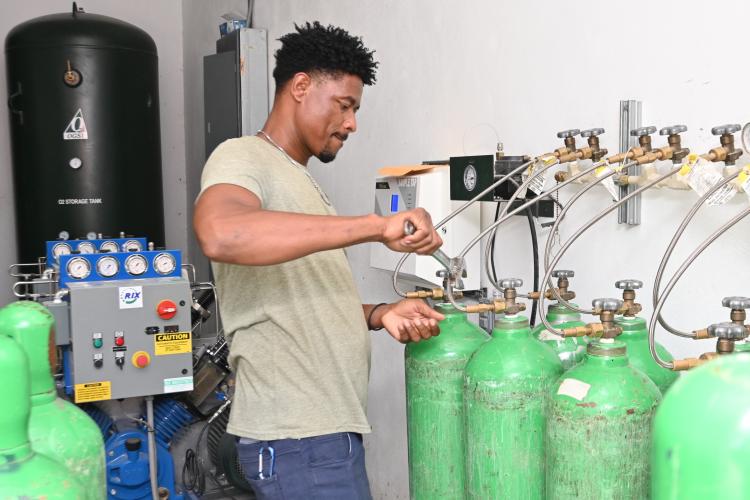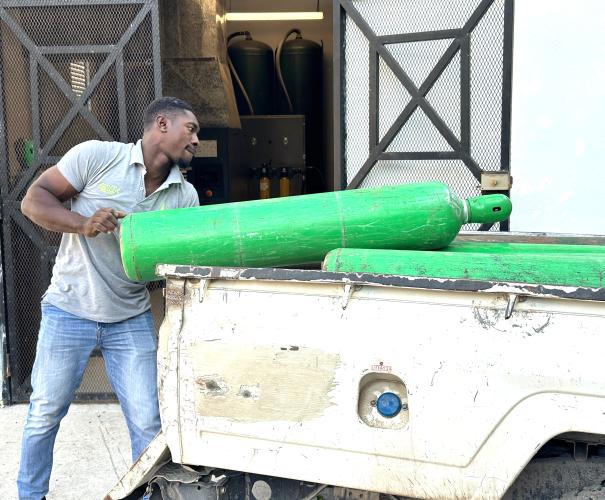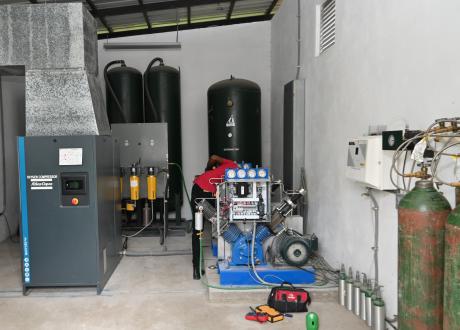“This is the first hospital I’ve been to that has welcomed me like this.”
Your support will help patients like Enoc access dignified care for tuberculosis and other infectious diseases.


Erick Jolicoeur switches out oxygen cylinders at the new filling station.
We are working hard to increase resilience and overcome every obstacle.
Medical oxygen is essential in surgery and for treating patients with pneumonia, tuberculosis, and other respiratory diseases—but its availability is not always guaranteed. As the World Health Organization notes, “In developing countries many health facilities lack uninterrupted access to medical oxygen, resulting in preventable deaths—a problem that [was] exacerbated by the COVID-19 pandemic, when the need for medical oxygen exceeded the capacities of many health systems.”

Wilmond Nocent will deliver oxygen to the hospital services.
St. Boniface Hospital has had oxygen production capabilities for more than ten years. However, the demand for oxygen grew along with our patient numbers, while our aging system required ever more maintenance and repair. Even at its best, it could produce only nine cylinders of oxygen in 24 hours. The COVID-19 pandemic made it clear that we needed a new and larger oxygen plant to ensure the supply of this irreplaceable medicine for our patients.
Through a project launched in 2021 with financial support from the W.K. Kellogg Foundation, our close partner Build Health International (BHI) began creating a pressure swing adsorption (PSA) oxygen plant for the hospital. Throughout the construction process, our team was forced to overcome seemingly every imaginable obstacle. The crises in Haiti made it difficult—and often impossible—to procure and transport the necessary resources. When a critical oxygen compressor broke, travel restrictions slowed its repair. All the while, our supply chain team worked hard to procure enough oxygen from other sources to meet the hospital’s needs—and they carefully monitored our daily oxygen supplies to ensure we were never without this life-saving resource.
After many months of challenges and adversity, our new oxygen plant was finished and ready for use. Our biomedical and facilities teams switched on the system with remote support from consultant Tom Monaghan (Senior Biomedical Engineer at BHI and former Chief Biomedical Engineering Officer at St. Boniface Hospital). Suddenly, after years of hard work and persistence, we were producing enough oxygen to meet our patients’ needs.

Our new oxygen plant can now produce 50 cylinders per day.

Alix Ilophene, Chief Biomedical Engineering Officer, examines one of the oxygen compressors.
Dr. Alexis Moïse, who oversees inpatient care at SBH, is grateful for everyone involved in the project. He says, “80-85% of our inpatients arrive in need of oxygen therapy. If there is a shortage because of the sociopolitical situation in the country, then patients can rapidly fall into hypoxia and even die. With the new capacity to produce our own oxygen at the hospital, we have fewer deaths.”
We will continue to pursue initiatives that build resilience and allow us to continue operating independently, no matter what new crises may arise. But for today, we are content to hear our new oxygen plant humming with activity. To our ears, it is the sound of life.
Your support will help patients like Enoc access dignified care for tuberculosis and other infectious diseases.
